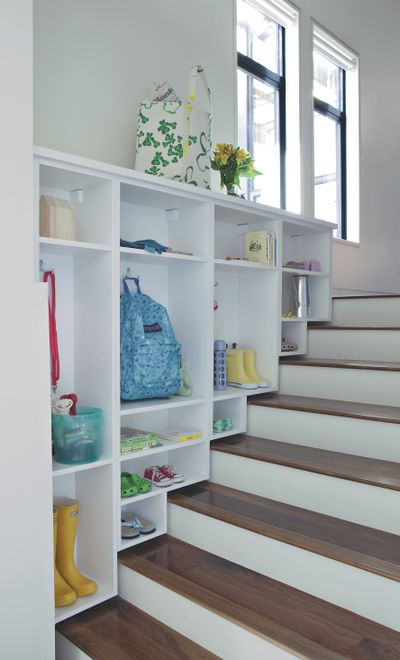Standing out, step by step
Well-decorated stairway can make a welcoming statement

Yet too often it’s among a home’s last-decorated features.
“So many clients say we have to get to it, but put it off until stage two,” says suburban New York designer Lori Elder Dyner, who writes a blog, Return to Home Interiors.
One reason may be that deciding what to do gets complicated. Many designers and architects recommend letting your home’s style, budget and amount of traffic guide you.
“We’re definitely influenced by the architecture and client’s style,” says Chicago architect Elissa Morgante of Morgante-Wilson Architects. But a stairway can also be an opportunity to bring light into a home’s center with clerestory or skylight at the top. Here are 10 steps to guide you:
1. If the stairway doesn’t work – isn’t visually graceful or was constructed poorly – consider replacing it if you can afford to, says Los Angeles designer Christopher Grubb of Arch-Interiors Group. His goal is for homeowners to enjoy the view from downstairs looking up as well as upstairs looking down.
2. If you desire a contemporary look, think about a floating stair, especially within an open space. Architect Chris Berg of Berg & Moss Architects in Beacon, N.Y., did so in a Tribeca loft with old-growth salvaged wood, which was sanded and stained, left bare and paired with a steel cable railing.
3. Oak and walnut hold up better than pine, and medium to darker stains show less dirt than lighter hues, as well as expand space visually, says New York Decorating Den Interiors designer Marinna Collelo. But don’t go too dark, warns Grubb, who considers dark espresso passe. The guiding principle: consistency. “The hallway stairs should be treated as a continuation of surrounding floors and not a separate space,” says Chicago designer Michael Del Pero.
4. Dyner thinks that homeowners with young children and dogs should add a runner. “I learned the hard way, slipping with my infant in my arms, and having my toddler slip only minutes after I did,” she says. The runner also deadens noise and looks best with 3 to 5 inches of wood or other flooring on either side. To save funds, Dyner used a narrow banding and stopped the runner at the lip of her upstairs stairs. Others may prefer wider bands, maybe with a contrasting material like leather.
5. Go with top quality carpeting, which often means 100 percent wool. “It holds up well with foot traffic, especially if you allow shoes on stairs,” Dyner says. Wool is also the most crush-resistant fiber and softest on bare feet,” says California designer S.A. “Sam” Jernigan of Renaissance Design Consultations.
6. For carpet color, the gray-beige family is a hot trend that works as a neutral, but go with darker choices if you allow shoes beyond the front door, Dyner says. Don’t go with the very darkest that show more soil, but try for a 7 on a scale of 10, says Phil Liss of Peerless Imported Rugs in Chicago. To find the right color and pattern, test samples at home. And make a carpet work with choices in adjoining spaces, says Nader Bolour, owner of New York carpet company Doris Leslie Blau.
7. Painting treads and risers or a faux runner in a bold color can be whimsical, but beware that results may look casual, says Janet Bertin, with Decorating Den Interiors, Alexandria, Va.
8. Another hot trend is lacquering a banister black and painting spindles semi-gloss white. If risers are also painted, they can be the same white, though experts disagree whether to go flat or glossy.
9. For more storage, open the area underneath stairs and outfit with cubicles, says Ginny Snook Scott, chief design officer, California Closets.
10. If painting the interior stair wall, use a premium, scrubbable paint since the area can get dirty, says Jernigan.
Most important, love your choices. Stair design costs – materials and labor – can add up steeply.